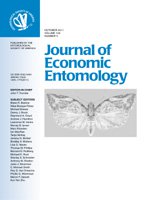The plum curculio, Conotrachelus nenuphar (Herbst), is a key pest of pome and stone fruit in eastern and central North America. For effective management of this insect pest in commercial apple (Malus spp.) orchards in the northeastern United States and Canada, one of the greatest challenges has been to determine the need for and timing of insecticide applications that will protect apple fruit from injury by adults. In a 2004–2005 study, we assessed the efficacy and economic viability of a reduced-risk integrated pest management strategy involving an odor-baited trap tree approach to determine need for and timing of insecticide use against plum curculio based on appearance of fresh egg-laying scars. Evaluations took place in commercial apple orchards in seven northeastern U.S. states. More specifically, we compared the trap-tree approach with three calendar-driven whole-block sprays and with heat-unit accumulation models that predict how long insecticide should be applied to orchard trees to prevent injury by plum curculio late in the season. Trap tree plots received a whole-plot insecticide spray by the time of petal fall, and succeeding sprays (if needed) were applied to peripheral-row trees only, depending on a threshold of one fresh plum curculio egg-laying scar out of 25 fruit sampled from a single trap tree. In both years, level of plum curculio injury to fruit sampled from perimeter-row, the most interior-row trees and whole-plot injury in trap tree plots did not differ significantly from that recorded in plots subject to conventional management or in plots managed using the heat-unit accumulation approach. The amount of insecticide used in trap tree plots was reduced at least by 43% compared with plots managed with the conventional approach. Advantages and potential pitfalls of the bio-based trap tree approach to plum curculio monitoring in apple orchards are discussed.
How to translate text using browser tools
1 October 2011
Effectiveness of Odor-Baited Trap Trees for Plum Curculio (Coleoptera: Curculionidae) Monitoring in Commercial Apple Orchards in the Northeast
Jaime C. Piñero,
Arthur M. Agnello,
Arthur Tuttle,
Tracy C. Leskey,
Heather Faubert,
Glen Koehler,
Lorraine Los,
Glenn Morin,
Kathleen Leahy,
Daniel R. Cooley,
Ronald J. Prokopy
ACCESS THE FULL ARTICLE
It is not available for individual sale.
This article is only available to subscribers.
It is not available for individual sale.
It is not available for individual sale.

Journal of Economic Entomology
Vol. 104 • No. 5
October 2011
Vol. 104 • No. 5
October 2011
aggregation
integrated pest management
monitoring
reduced-risk
semiochemicals




